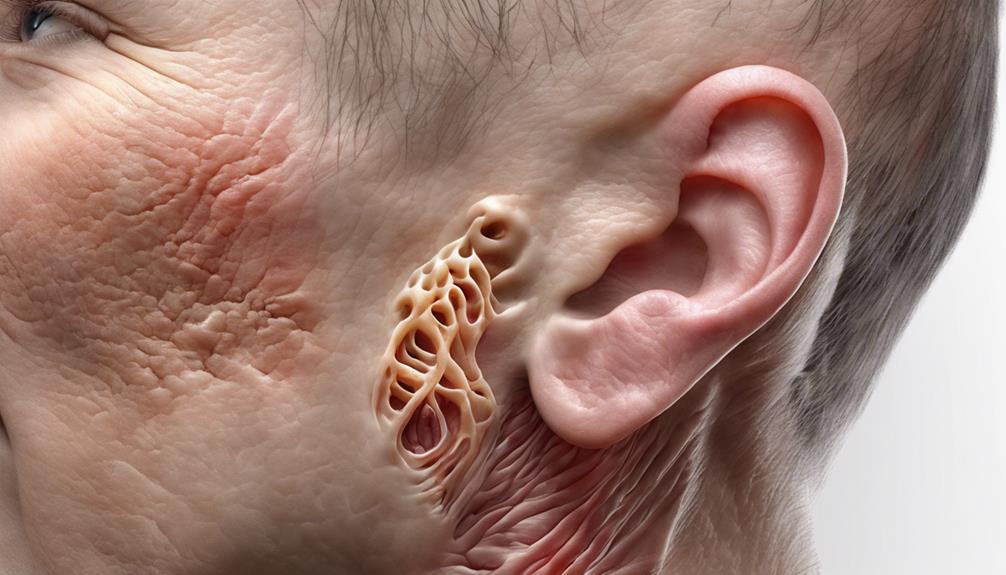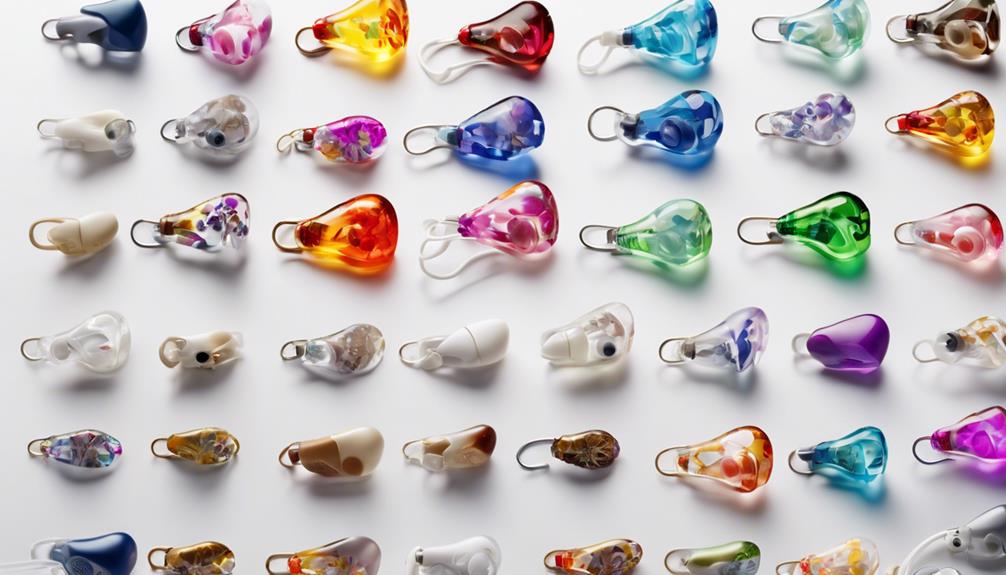Imagine the tranquility of a gentle rain shower on a peaceful morning – now, consider the importance of safeguarding your hearing aids in these conditions.
We all cherish our devices, and ensuring their waterproofing can be a game-changer. From simple storage tactics to advanced waterproof options, there are various ways to shield your hearing aids.
But how can you be certain you're doing it right? Let's navigate the waters together and discover foolproof techniques to keep your hearing aids dry and functional in any environment.
Key Takeaways
- Choose hearing aids with high IP ratings for better water resistance.
- Recognize signs of water damage to address issues promptly.
- Use waterproof accessories and maintenance for long-lasting protection.
- Employ drying methods to prevent moisture-related damage and ensure optimal functionality.
Understanding Water Resistance Ratings
When selecting waterproof hearing aids, it's essential to grasp the significance of IP ratings to ensure adequate protection against water and dust. IP ratings classify the level of protection a device offers against solids and liquids, with higher ratings indicating better resistance. For hearing aids, the second digit in the IP rating is particularly crucial as it signifies the level of water resistance. Hearing aids with higher IP ratings are ideal for use in high-moisture environments or during activities involving water exposure.
Understanding IP ratings is vital in choosing the right level of water resistance for hearing aids to prevent damage from moisture. For instance, an IP67 rating means the device is protected against solid objects and can withstand short water exposure. By selecting hearing aids with appropriate IP ratings, one can ensure the longevity and performance of the devices, especially in conditions where exposure to water and moisture is common. Make an informed choice to safeguard your hearing aids from potential water-related harm.
Signs of Water Damage in Hearing Aids

Understanding the warning signs of water damage in hearing aids is crucial for maintaining their optimal functionality and performance. Here are four key signs to watch out for:
- Static Sounds: Hearing aids affected by water damage may produce static or crackling sounds, indicating moisture has infiltrated the device.
- Volume Fluctuations: If you notice sudden changes in volume levels or irregularities in sound output, it could be a sign of water-related issues within the hearing aids.
- Sweat Accumulation: Accumulated sweat in In-The-Ear (ITE), Receiver-In-Canal (RIC), and Behind-The-Ear (BTE) hearing aids can suggest water damage and the need for immediate attention.
- Distorted Sounds: Hearing aids experiencing water damage may produce distorted sounds, impacting the clarity and quality of the audio signal.
Being vigilant for these signs can help you address water damage promptly, preventing further issues like corrosion and ensuring your hearing aids function effectively.
Tips for Protecting Hearing Aids in Water
To safeguard your hearing aids from water damage, it is essential to follow practical tips for protection and maintenance. When it comes to protecting your hearing aids in water, there are several key strategies to consider. Here are some tips to help you keep your hearing aids safe and functioning optimally:
| Tips for Protecting Hearing Aids in Water | |
|---|---|
| Waterproof Hearing Aids | Look for hearing aids specifically designed to be waterproof, like those with an IP67 rating, which can be submerged up to 50 cm in water. These aids provide superior protection against moisture. |
| Accessories | Consider using accessories such as hearing aid covers and sleeves to add an extra layer of protection against water and moisture. These accessories can help safeguard the high-tech circuit boards and battery compartment of your hearing aids. |
| Regular Maintenance | Ensure that rubber seals on your hearing aids are intact and in good condition. Regularly check and replace these seals to maintain the water-resistant properties of your devices. |
Best Waterproof Hearing Aids for 2023

For individuals seeking reliable protection against water damage for their hearing aids in 2023, exploring the latest advancements in waterproof technology is essential. When choosing the best waterproof hearing aids for the year, consider the following:
- Phonak Audeo Life: This hearing aid is waterproof and can withstand submersion up to 50 cm in water, providing excellent protection against moisture.
- IP Ratings: Look for devices with IP67 ratings, indicating a high level of water resistance and safeguarding against short water exposure, ideal for various environments.
- Recommended for Excessive Moisture: Waterproof hearing aids are particularly suitable for individuals exposed to heavy perspiration or humid climates, ensuring longevity and preventing water damage.
- Preventive Measures: To avoid water damage and the need for hearing aid repairs, remember to remove hearing aids before water exposure and opt for waterproof options to maintain their functionality.
How to Dry Out Moisture From Hearing Aids
Regularly drying out moisture from your hearing aids is crucial to prevent damage and maintain optimal performance. Moisture accumulation in hearing aids can lead to issues like static sounds and distorted sound quality, affecting your hearing experience. To effectively remove moisture and protect your device, consider utilizing a hearing aid drying box. Additionally, leaving the battery compartment open overnight can help dry out any accumulated moisture. Moisture can cause corrosion in hearing aids, leading to intermittent outages and potential device failure, ultimately impacting your ability to hear clearly. By implementing these drying methods, you can prolong the lifespan of your hearing aids and ensure they continue to function correctly. Remember, taking proactive steps to keep your hearing aids dry and free from moisture is essential in preventing damage and safeguarding against hearing loss.
| Hearing Aid Drying Methods | Benefits |
|---|---|
| Use a drying box | Removes moisture effectively |
| Leave battery compartment open overnight | Helps evaporate accumulated moisture |
| Regularly maintain dryness | Prolongs hearing aid lifespan |
Frequently Asked Questions
How Do You Waterproof a Hearing Aid?
We waterproof a hearing aid by using water-resistant covers, selecting devices with higher IP ratings, applying nanotechnology coatings, utilizing dehumidifiers, and storing them in waterproof containers.
These methods help protect the hearing aids from moisture and corrosion. It's essential to avoid submerging the devices in water to maintain their functionality.
How Do You Keep Moisture Out of Hearing Aids?
We keep moisture out of hearing aids by adopting proper maintenance habits. Regularly wiping down the devices, using a dehumidifier, and storing them in a dry place can help prevent moisture-related issues.
Avoid exposing the hearing aids to excessive sweat, humidity, or rain. These practices ensure the longevity and optimal performance of the devices.
How Do I Keep My Hearing Aid From Getting Wet?
We keep our hearing aids dry by following a few key steps:
- Storing them in a waterproof container when not in use
- Avoiding wearing them in water or heavy rain
- Using a hearing aid drying box to remove moisture and extend the device's lifespan
- Considering waterproof covers for added protection
- Consulting an audiologist for advice on water-resistant hearing aid options
These measures help prevent moisture-related damage and ensure that our hearing aids continue to function optimally.
Can You Swim With Waterproof Hearing Aids?
Yes, we can swim with waterproof hearing aids! These devices are designed to withstand water exposure, allowing us to enjoy swimming without removing them.
With high water resistance and IP ratings, waterproof hearing aids like the Phonak Audeo Life can be submerged up to 50 cm.
Choosing such options ensures we can engage in water-related activities with confidence, without worrying about damaging our hearing aids.
Conclusion
In conclusion, ensuring the waterproofing of your hearing aids is crucial for their longevity and performance. By following the tips and recommendations outlined in this guide, you can protect your devices from water damage and enhance their durability.
Remember, prevention is key to keeping your hearing aids functioning optimally in wet conditions.
Stay tuned for more updates on the latest waterproof hearing aid options for 2023!











